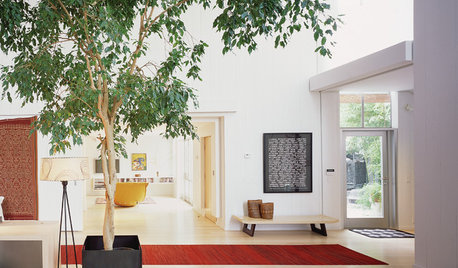37yr old Ficus dropping green leaves like crazy
DCrez
12 years ago
Related Stories

HOUSEPLANTSHow to Grow a Happy Ficus
This houseplant’s reputation for being fussy shouldn’t prevent you from growing and enjoying it for years
Full Story
MOST POPULARHow to Reface Your Old Kitchen Cabinets
Find out what’s involved in updating your cabinets by refinishing or replacing doors and drawers
Full Story
MOST POPULAREasy Green: 23 Ways to Reduce Waste at Home
Pick from this plethora of earth-friendly ideas to send less to the landfill and keep more money in your pocket
Full Story
FUN HOUZZDouble Take: Did MoMA Drop a Mini House in the Yard?
Or maybe it's garden art or even a modernist-loving giant's step stool. Use your imagination, then get the true tale here
Full Story
MOST POPULARExclusive Video of Wright’s Jaw-Dropping Hollyhock House
Immerse yourself in the stunningly restored Frank Lloyd Wright masterpiece
Full Story
FALL GARDENING5 Ways to Put Fall Leaves to Work in Your Garden
Improve your soil and yard the organic way with a valuable garden booster that grows on trees
Full Story
KITCHEN OF THE WEEKKitchen of the Week: Goodbye, Honey Oak — Hello, Minty Green
After more than 30 years, the Kloesels revamped their space to reflect their rural country town and Victorian-style home
Full Story
FURNITUREOld Furniture: Clean, Reupholster or Replace It?
A veteran upholstery cleaner weighs in on the options for found, inherited and thrift store furniture
Full Story
UPHOLSTERYThe Perks and Perils of Reupholstering Old Furniture
Secondhand upholstered pieces can add character to a room, but beware of bugs, snakes and hidden costs
Full Story
CHRISTMASHow to Light Your Christmas Tree Like a Pro
Give yourself frustration-free tree lighting this year — the trick is clever cord management
Full Story





birdsnblooms
DCrezOriginal Author
Related Professionals
Panama City Landscape Architects & Landscape Designers · Mount Wilson Landscape Architects & Landscape Designers · Avocado Heights Landscape Contractors · Aberdeen Landscape Contractors · Desert Hot Springs Landscape Contractors · Fridley Landscape Contractors · Louisville Landscape Contractors · Manhattan Landscape Contractors · Mastic Beach Landscape Contractors · New Braunfels Landscape Contractors · Painesville Landscape Contractors · Pueblo West Landscape Contractors · Santa Maria Landscape Contractors · Tustin Landscape Contractors · Washington Interior Designers & Decoratorsbirdsnblooms
DCrezOriginal Author
pirate_girl
tapla (mid-Michigan, USDA z5b-6a)
greattigerdane
DCrezOriginal Author